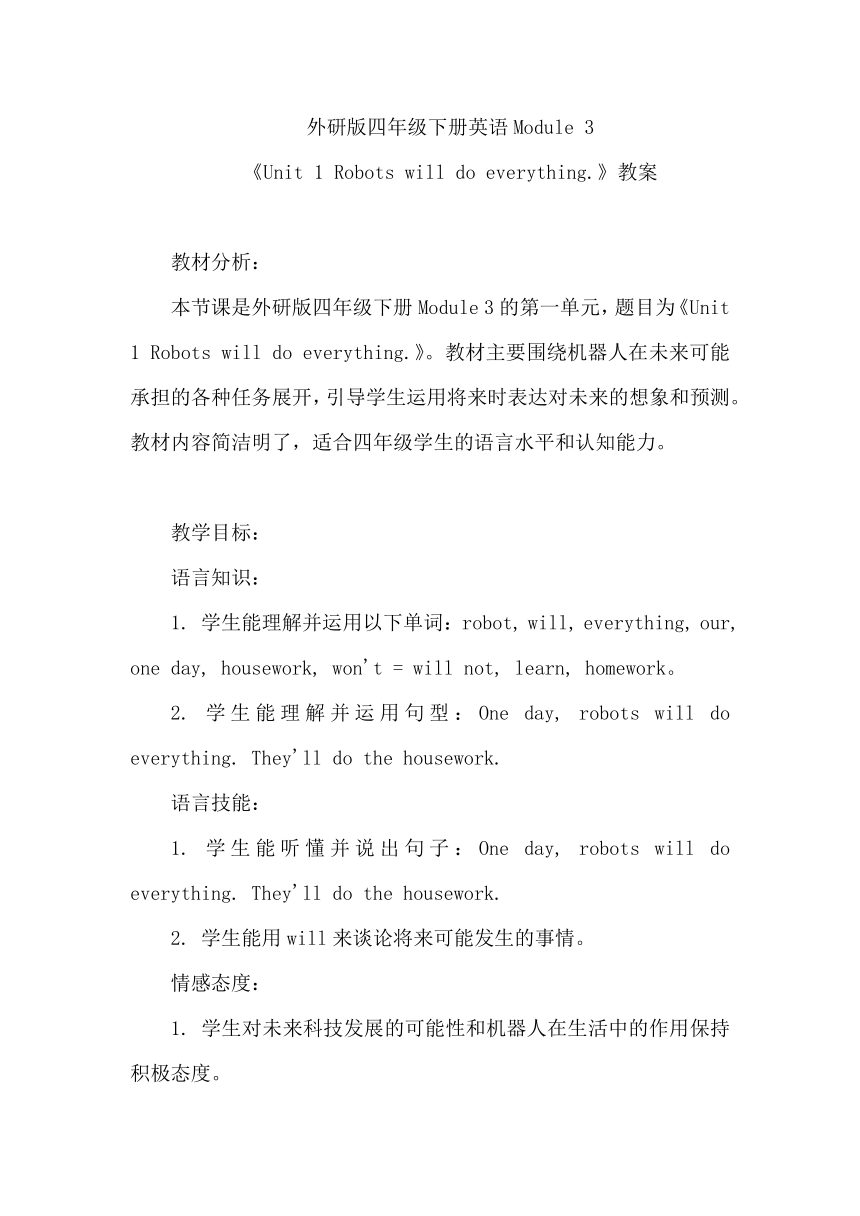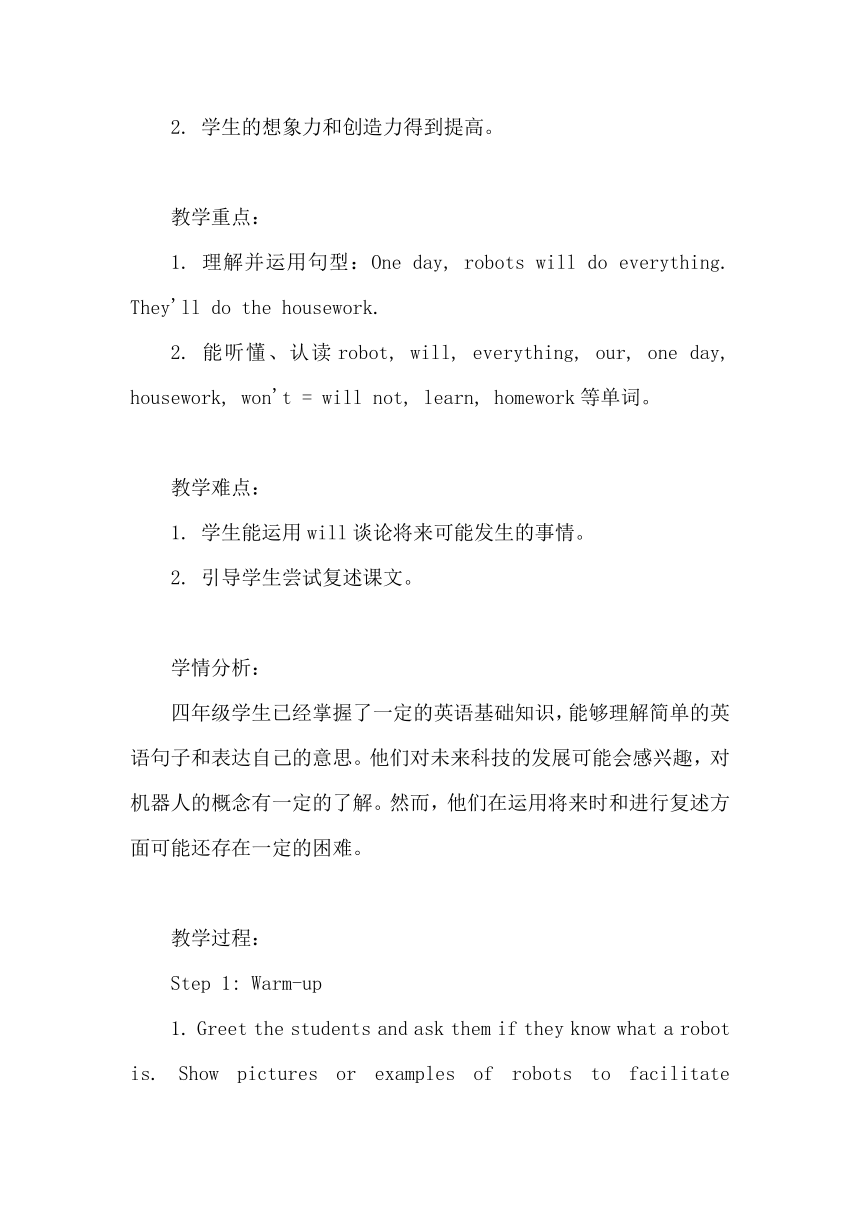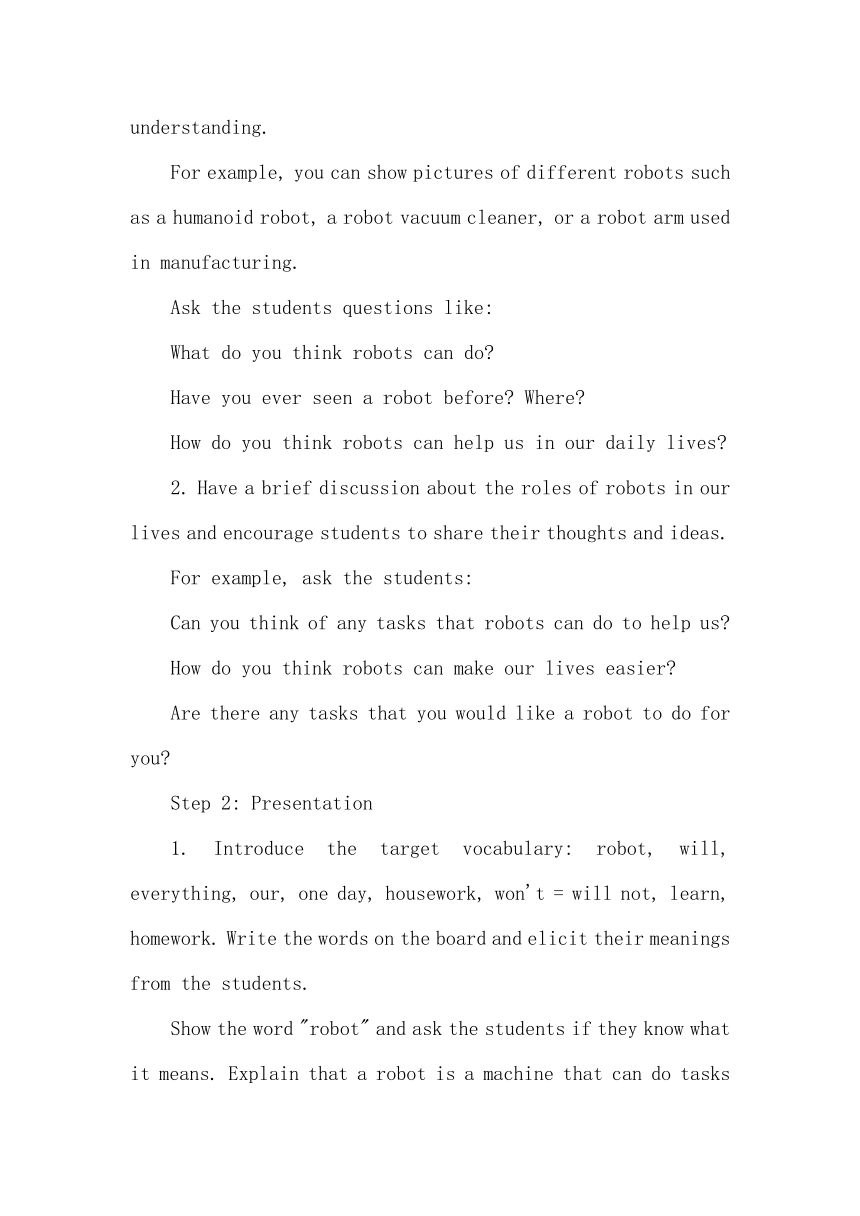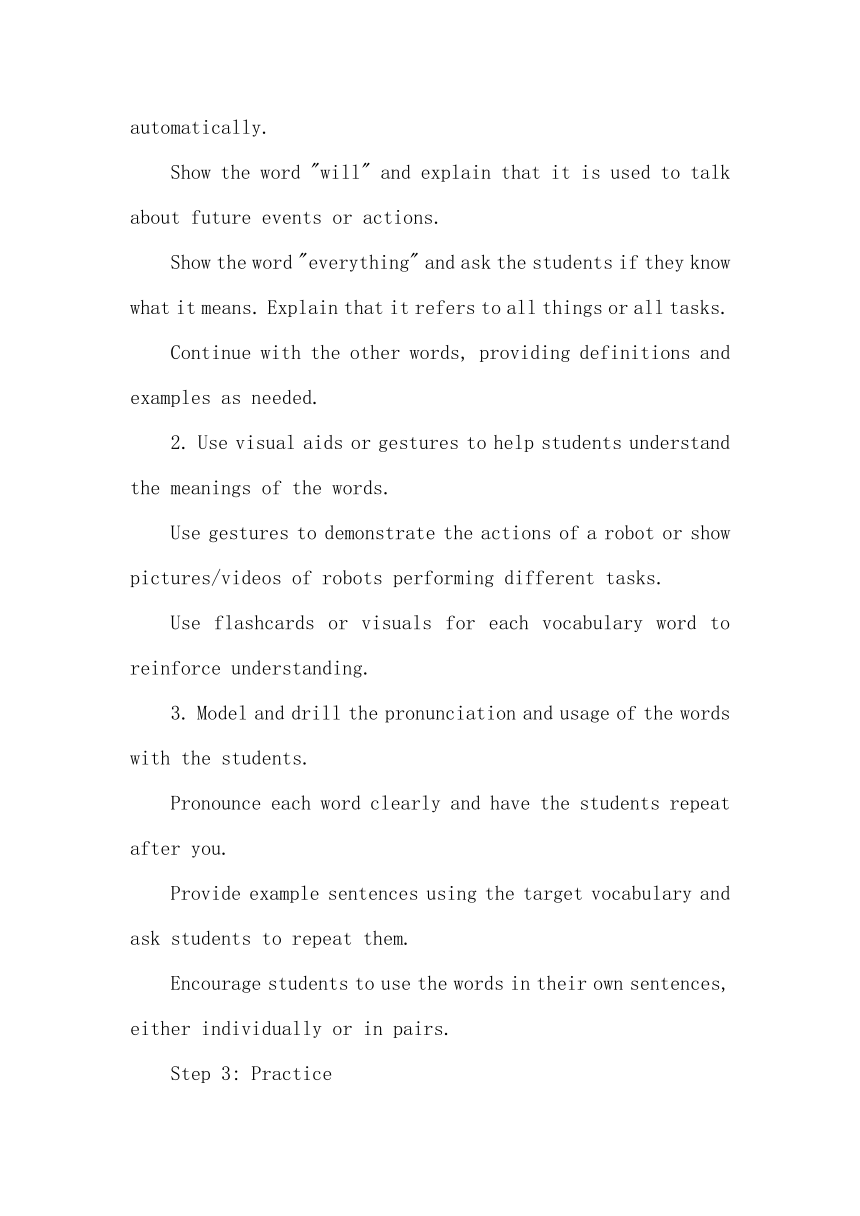Module 3 Unit 1 Robots will do everything 教案(含反思)
文档属性
| 名称 | Module 3 Unit 1 Robots will do everything 教案(含反思) |  | |
| 格式 | docx | ||
| 文件大小 | 15.3KB | ||
| 资源类型 | 教案 | ||
| 版本资源 | 外研版(三年级起点) | ||
| 科目 | 英语 | ||
| 更新时间 | 2024-03-11 10:42:59 | ||
图片预览





文档简介
外研版四年级下册英语Module 3
《Unit 1 Robots will do everything.》教案
教材分析:
本节课是外研版四年级下册Module 3的第一单元,题目为《Unit 1 Robots will do everything.》。教材主要围绕机器人在未来可能承担的各种任务展开,引导学生运用将来时表达对未来的想象和预测。教材内容简洁明了,适合四年级学生的语言水平和认知能力。
教学目标:
语言知识:
1. 学生能理解并运用以下单词:robot, will, everything, our, one day, housework, won't = will not, learn, homework。
2. 学生能理解并运用句型:One day, robots will do everything. They'll do the housework.
语言技能:
1. 学生能听懂并说出句子:One day, robots will do everything. They'll do the housework.
2. 学生能用will来谈论将来可能发生的事情。
情感态度:
1. 学生对未来科技发展的可能性和机器人在生活中的作用保持积极态度。
2. 学生的想象力和创造力得到提高。
教学重点:
1. 理解并运用句型:One day, robots will do everything. They'll do the housework.
2. 能听懂、认读robot, will, everything, our, one day, housework, won't = will not, learn, homework等单词。
教学难点:
1. 学生能运用will谈论将来可能发生的事情。
2. 引导学生尝试复述课文。
学情分析:
四年级学生已经掌握了一定的英语基础知识,能够理解简单的英语句子和表达自己的意思。他们对未来科技的发展可能会感兴趣,对机器人的概念有一定的了解。然而,他们在运用将来时和进行复述方面可能还存在一定的困难。
教学过程:
Step 1: Warm-up
1. Greet the students and ask them if they know what a robot is. Show pictures or examples of robots to facilitate understanding.
For example, you can show pictures of different robots such as a humanoid robot, a robot vacuum cleaner, or a robot arm used in manufacturing.
Ask the students questions like:
What do you think robots can do
Have you ever seen a robot before Where
How do you think robots can help us in our daily lives
2. Have a brief discussion about the roles of robots in our lives and encourage students to share their thoughts and ideas.
For example, ask the students:
Can you think of any tasks that robots can do to help us
How do you think robots can make our lives easier
Are there any tasks that you would like a robot to do for you
Step 2: Presentation
1. Introduce the target vocabulary: robot, will, everything, our, one day, housework, won't = will not, learn, homework. Write the words on the board and elicit their meanings from the students.
Show the word "robot" and ask the students if they know what it means. Explain that a robot is a machine that can do tasks automatically.
Show the word "will" and explain that it is used to talk about future events or actions.
Show the word "everything" and ask the students if they know what it means. Explain that it refers to all things or all tasks.
Continue with the other words, providing definitions and examples as needed.
2. Use visual aids or gestures to help students understand the meanings of the words.
Use gestures to demonstrate the actions of a robot or show pictures/videos of robots performing different tasks.
Use flashcards or visuals for each vocabulary word to reinforce understanding.
3. Model and drill the pronunciation and usage of the words with the students.
Pronounce each word clearly and have the students repeat after you.
Provide example sentences using the target vocabulary and ask students to repeat them.
Encourage students to use the words in their own sentences, either individually or in pairs.
Step 3: Practice
1. Read the sentence "One day, robots will do everything. They'll do the housework" aloud and ask students to repeat after you.
Break down the sentence and emphasize the key vocabulary words and sentence structure.
Model the sentence and ask students to repeat it multiple times to practice pronunciation and intonation.
2. Divide the class into pairs or small groups. Have them take turns to ask and answer questions about future possibilities using the target vocabulary.
Provide sentence starters for the students to complete, such as:
What will robots do in the future
Will robots do our homework
Will robots learn new things
Encourage students to use complete sentences and the target vocabulary in their responses.
Monitor the groups and provide assistance or feedback as needed.
Step 4: Listening and Speaking
1. Play an audio recording of a short dialogue or story related to robots and their future roles.
Choose a dialogue or story that introduces new vocabulary words or reinforces the target sentence pattern.
Ensure the audio is clear and at an appropriate pace for the students to understand.
Pause the audio at key points to check comprehension and elicit predictions from the students.
2. Ask students to listen carefully and answer questions about the dialogue or story.
Prepare comprehension questions related to the content of the audio.
Encourage students to actively listen for specific details and main ideas.
3. Have students discuss in pairs or small groups what they think about the ideas presented in the dialogue or story.
Encourage students to express their opinions using the target vocabulary and sentence pattern.
Provide guiding questions to stimulate discussion, such as:
Do you agree or disagree with the ideas in the dialogue/story Why
How do you imagine robots will help us in the future
Are there any tasks you would not want robots to do Why
Step 5: Reading and Writing
1. Provide each student with a short passage or a picture related to robots and their future roles.
Choose a text or image that showcases different tasks robots may do in the future.
Ensure the passage or picture includes instances of the target vocabulary and sentence pattern.
2. Have students read the passage or describe the picture using the target vocabulary and sentence pattern.
Encourage students to read the passage aloud or describe the picture to a partner.
Monitor their progress and provide support as needed.
3. Ask students to work individually or in pairs to write a short paragraph about what they think robots will do in the future.
Encourage them to be creative and use the target vocabulary and sentence pattern.
For example, a student might write:
"In the future, robots will do everything! They will clean our houses, cook our meals, and even walk our pets. They won't just do simple tasks, but they will also learn new things. Robots will be like our personal assistants, helping us with all our daily activities. I think it will be amazing to have robots that can do our homework for us. They will be able to learn and understand different subjects, making studying so much easier!"
4. Ask several students to share their paragraphs with the class, promoting discussion and providing feedback.
Select a few students to read their paragraphs aloud.
Encourage other students to listen and provide positive feedback or ask questions about their classmates' ideas.
Foster a supportive and inclusive learning environment.
Step 6: Recap and Closure
1. Summarize the main points of the lesson, emphasizing the target vocabulary and sentence pattern.
Review the key vocabulary words and their meanings.
Remind students of the sentence pattern: "One day, robots will [verb]. They'll [verb]."
2. Ask students to reflect on what they have learned and discuss their favorite part of the lesson.
Encourage students to share their thoughts on what they found interesting or exciting about robots and their future roles.
Facilitate a brief class discussion, allowing students to express their opinions and ask questions.
3. Provide positive feedback and encourage students to continue exploring the topic of robots and future technology.
Acknowledge students' participation and effort throughout the lesson.
Highlight the importance of exploring new ideas and embracing technological advancements.
Suggest additional resources or activities for students to further explore the topic if they are interested.
It's important to adapt the lesson to the specific age and proficiency level of the students. The examples provided here are general and can be modified to suit different classroom contexts.
板书设计:
One day, robots will do everything.
They'll do the housework.
Vocabulary:
Robot, will, everything, our, one day, housework,
won't = will not, learn,
Homework
教学反思:
本节课通过引导学生讨论和想象未来机器人的作用,帮助他们理解并运用将来时的句型。通过听说读写的综合训练,培养了学生的语言技能和表达能力。教学过程中,教师利用图片、对话和练习等多种形式激发学生的兴趣,提高了他们的参与度。同时,通过个别展示和小组讨论等形式,促进了学生之间的合作和互动。在教学反思中,教师可以总结学生的学习情况,评价他们的表现,并指出需要进一步加强的地方,以便进行后续的教学调整。
《Unit 1 Robots will do everything.》教案
教材分析:
本节课是外研版四年级下册Module 3的第一单元,题目为《Unit 1 Robots will do everything.》。教材主要围绕机器人在未来可能承担的各种任务展开,引导学生运用将来时表达对未来的想象和预测。教材内容简洁明了,适合四年级学生的语言水平和认知能力。
教学目标:
语言知识:
1. 学生能理解并运用以下单词:robot, will, everything, our, one day, housework, won't = will not, learn, homework。
2. 学生能理解并运用句型:One day, robots will do everything. They'll do the housework.
语言技能:
1. 学生能听懂并说出句子:One day, robots will do everything. They'll do the housework.
2. 学生能用will来谈论将来可能发生的事情。
情感态度:
1. 学生对未来科技发展的可能性和机器人在生活中的作用保持积极态度。
2. 学生的想象力和创造力得到提高。
教学重点:
1. 理解并运用句型:One day, robots will do everything. They'll do the housework.
2. 能听懂、认读robot, will, everything, our, one day, housework, won't = will not, learn, homework等单词。
教学难点:
1. 学生能运用will谈论将来可能发生的事情。
2. 引导学生尝试复述课文。
学情分析:
四年级学生已经掌握了一定的英语基础知识,能够理解简单的英语句子和表达自己的意思。他们对未来科技的发展可能会感兴趣,对机器人的概念有一定的了解。然而,他们在运用将来时和进行复述方面可能还存在一定的困难。
教学过程:
Step 1: Warm-up
1. Greet the students and ask them if they know what a robot is. Show pictures or examples of robots to facilitate understanding.
For example, you can show pictures of different robots such as a humanoid robot, a robot vacuum cleaner, or a robot arm used in manufacturing.
Ask the students questions like:
What do you think robots can do
Have you ever seen a robot before Where
How do you think robots can help us in our daily lives
2. Have a brief discussion about the roles of robots in our lives and encourage students to share their thoughts and ideas.
For example, ask the students:
Can you think of any tasks that robots can do to help us
How do you think robots can make our lives easier
Are there any tasks that you would like a robot to do for you
Step 2: Presentation
1. Introduce the target vocabulary: robot, will, everything, our, one day, housework, won't = will not, learn, homework. Write the words on the board and elicit their meanings from the students.
Show the word "robot" and ask the students if they know what it means. Explain that a robot is a machine that can do tasks automatically.
Show the word "will" and explain that it is used to talk about future events or actions.
Show the word "everything" and ask the students if they know what it means. Explain that it refers to all things or all tasks.
Continue with the other words, providing definitions and examples as needed.
2. Use visual aids or gestures to help students understand the meanings of the words.
Use gestures to demonstrate the actions of a robot or show pictures/videos of robots performing different tasks.
Use flashcards or visuals for each vocabulary word to reinforce understanding.
3. Model and drill the pronunciation and usage of the words with the students.
Pronounce each word clearly and have the students repeat after you.
Provide example sentences using the target vocabulary and ask students to repeat them.
Encourage students to use the words in their own sentences, either individually or in pairs.
Step 3: Practice
1. Read the sentence "One day, robots will do everything. They'll do the housework" aloud and ask students to repeat after you.
Break down the sentence and emphasize the key vocabulary words and sentence structure.
Model the sentence and ask students to repeat it multiple times to practice pronunciation and intonation.
2. Divide the class into pairs or small groups. Have them take turns to ask and answer questions about future possibilities using the target vocabulary.
Provide sentence starters for the students to complete, such as:
What will robots do in the future
Will robots do our homework
Will robots learn new things
Encourage students to use complete sentences and the target vocabulary in their responses.
Monitor the groups and provide assistance or feedback as needed.
Step 4: Listening and Speaking
1. Play an audio recording of a short dialogue or story related to robots and their future roles.
Choose a dialogue or story that introduces new vocabulary words or reinforces the target sentence pattern.
Ensure the audio is clear and at an appropriate pace for the students to understand.
Pause the audio at key points to check comprehension and elicit predictions from the students.
2. Ask students to listen carefully and answer questions about the dialogue or story.
Prepare comprehension questions related to the content of the audio.
Encourage students to actively listen for specific details and main ideas.
3. Have students discuss in pairs or small groups what they think about the ideas presented in the dialogue or story.
Encourage students to express their opinions using the target vocabulary and sentence pattern.
Provide guiding questions to stimulate discussion, such as:
Do you agree or disagree with the ideas in the dialogue/story Why
How do you imagine robots will help us in the future
Are there any tasks you would not want robots to do Why
Step 5: Reading and Writing
1. Provide each student with a short passage or a picture related to robots and their future roles.
Choose a text or image that showcases different tasks robots may do in the future.
Ensure the passage or picture includes instances of the target vocabulary and sentence pattern.
2. Have students read the passage or describe the picture using the target vocabulary and sentence pattern.
Encourage students to read the passage aloud or describe the picture to a partner.
Monitor their progress and provide support as needed.
3. Ask students to work individually or in pairs to write a short paragraph about what they think robots will do in the future.
Encourage them to be creative and use the target vocabulary and sentence pattern.
For example, a student might write:
"In the future, robots will do everything! They will clean our houses, cook our meals, and even walk our pets. They won't just do simple tasks, but they will also learn new things. Robots will be like our personal assistants, helping us with all our daily activities. I think it will be amazing to have robots that can do our homework for us. They will be able to learn and understand different subjects, making studying so much easier!"
4. Ask several students to share their paragraphs with the class, promoting discussion and providing feedback.
Select a few students to read their paragraphs aloud.
Encourage other students to listen and provide positive feedback or ask questions about their classmates' ideas.
Foster a supportive and inclusive learning environment.
Step 6: Recap and Closure
1. Summarize the main points of the lesson, emphasizing the target vocabulary and sentence pattern.
Review the key vocabulary words and their meanings.
Remind students of the sentence pattern: "One day, robots will [verb]. They'll [verb]."
2. Ask students to reflect on what they have learned and discuss their favorite part of the lesson.
Encourage students to share their thoughts on what they found interesting or exciting about robots and their future roles.
Facilitate a brief class discussion, allowing students to express their opinions and ask questions.
3. Provide positive feedback and encourage students to continue exploring the topic of robots and future technology.
Acknowledge students' participation and effort throughout the lesson.
Highlight the importance of exploring new ideas and embracing technological advancements.
Suggest additional resources or activities for students to further explore the topic if they are interested.
It's important to adapt the lesson to the specific age and proficiency level of the students. The examples provided here are general and can be modified to suit different classroom contexts.
板书设计:
One day, robots will do everything.
They'll do the housework.
Vocabulary:
Robot, will, everything, our, one day, housework,
won't = will not, learn,
Homework
教学反思:
本节课通过引导学生讨论和想象未来机器人的作用,帮助他们理解并运用将来时的句型。通过听说读写的综合训练,培养了学生的语言技能和表达能力。教学过程中,教师利用图片、对话和练习等多种形式激发学生的兴趣,提高了他们的参与度。同时,通过个别展示和小组讨论等形式,促进了学生之间的合作和互动。在教学反思中,教师可以总结学生的学习情况,评价他们的表现,并指出需要进一步加强的地方,以便进行后续的教学调整。
同课章节目录
- Module 1
- Unit 1 She's a nice teache
- Unit 2 He's cool.
- Module 2
- Unit 1 London is a big city.
- Unit 2 It's very old.
- Module 3
- Unit 1 Robots will do everything.
- Unit 2 On Monday I'll go swimming.
- Module 4
- Unit 1 Will you take your kite?
- Unit 2 Will it be hot in Haikou?
- Module 5
- Unit 1 I was two then.
- Unit 2 They were young.
- Module 6
- Unit 1 Were you at home yesterday?
- Unit 2 Was it a big city then ?
- Module 7
- Unit 1 I helped Mum.
- Unit 2 Grandma cooked fish.
- Module 8
- Unit 1 They sang beautifully.
- Unit 2 I took some pictures.
- Module 9
- Unit 1 Did he live in New York ?
- Unit 2 Did you have a nice holiday?
- Review Module
- Unit 1
- Unit 2
- Module 10
- Unit 1 Did you fall off your bike?
- Unit 2 Sam had lots of chocolate.
